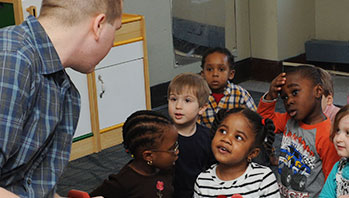- posterboard
- markers
- timer
- listen
- loud
- sound
- source
MA Standards:
Speaking and Listening/SL.PK.MA.1: Participate in collaborative conversations with diverse partners during daily routines and play.
Language/L.PK.MA.1: Demonstrate use of oral language in informal everyday activities.
Head Start Outcomes:
Language Development/Receptive Language: Attends to language during conversations, songs, stories, or other learning experiences.
Language Development/Expressive Language: Uses language to express ideas and needs.
Logic and Reasoning/Reasoning and Problem Solving: Seeks multiple solutions to a question, task, or problem.
Logic and Reasoning/Reasoning and Problem Solving: Recognizes cause and effect relationships.
PreK Learning Guidelines:
English Language Arts/Language 2: Participate actively in discussions, listen to the ideas of others, and ask and answer relevant questions.
Science and Technology/Living Things and Their Environment 15: Use their senses of sight, hearing, touch, smell, and taste to explore their environment using sensory vocabulary.
Talk Together: Point to the Sound

© Commonwealth of Massachusetts, Department of Early Education and Care (Jennifer Waddell photographer). All rights reserved.
STEM Key Concepts: Sounds have a source (A sound can be tracked to its source)
ELA Focus Skills: Active Listening, Following Directions
Educator Prep: Prepare a simple drawn map of the classroom with descriptive pictures to identify key areas. Before you begin discussion, hide a timer and set it for 5 minutes.
Revisit the idea that every sound has a source. Introduce the idea that every sound travels one way, or in one direction. Begin by asking children to listen to the sound you make with your voice. Say, I am going to turn my head and make a loud sound with my voice. Try to follow the sound, or listen to where the sound goes. Repeat the same gesture, turning your head in the opposite direction the second time. Say,
- Where did the sound go this time? Tell children that sometimes you can follow a sound to find its source, or the object that made it.
- When the timer goes off, point to where the sound came from and say, Why did you all turn your heads over there? Elicit from children that that is the direction the sound came from. Then say, Let’s find the source that the sound is coming from. Can you show me in which direction we should go to find it?
- Show children the map of the classroom. Say, Let’s find on the map where the sound came from. Can you point to the place on the map where the timer was? Repeat the activity, hiding the timer in a different location. This time, ask children to identify on the map where the timer is. Say, Point to where you think the sound is coming from. Where is the place on the map? Allow children time to discover the timer using the map.
